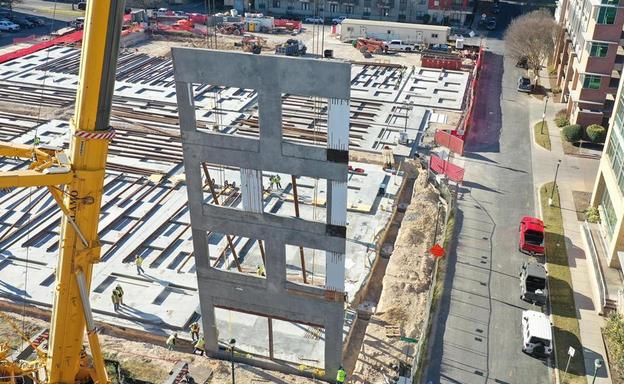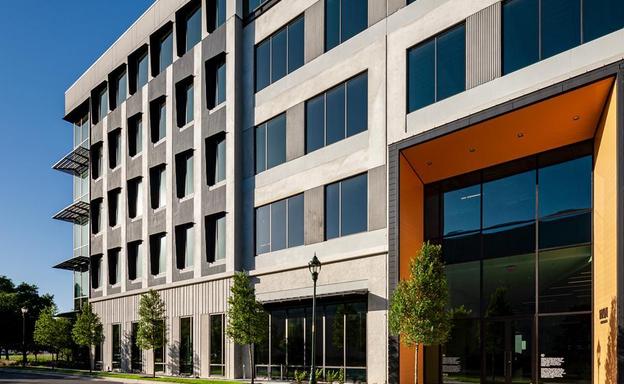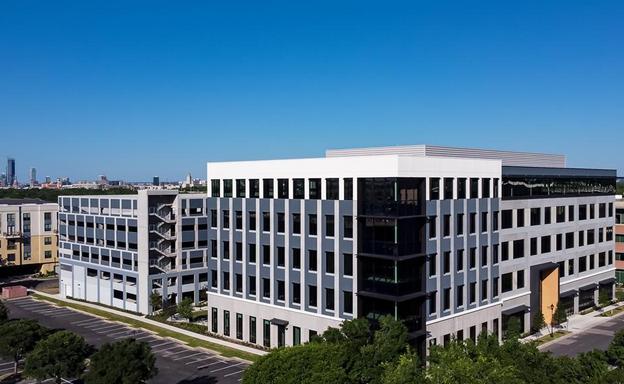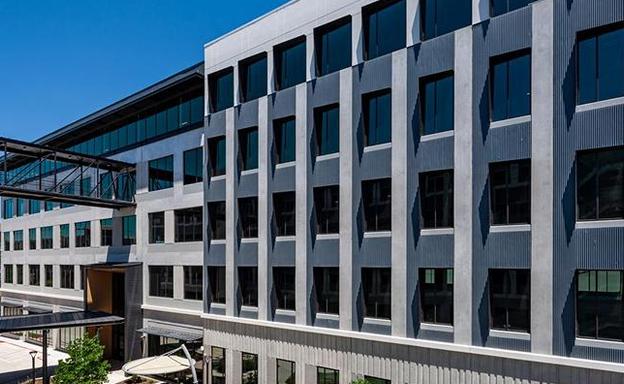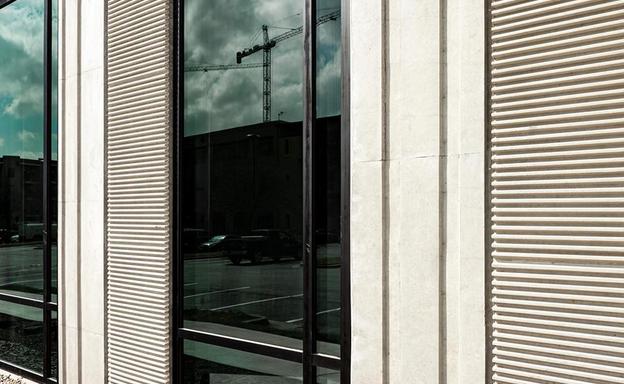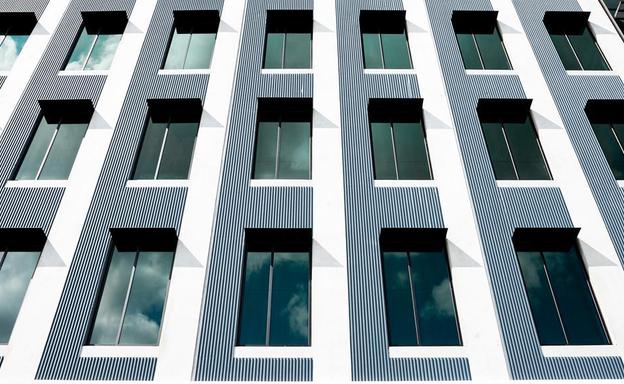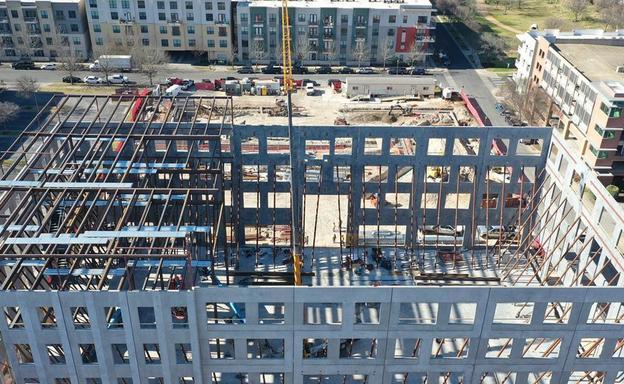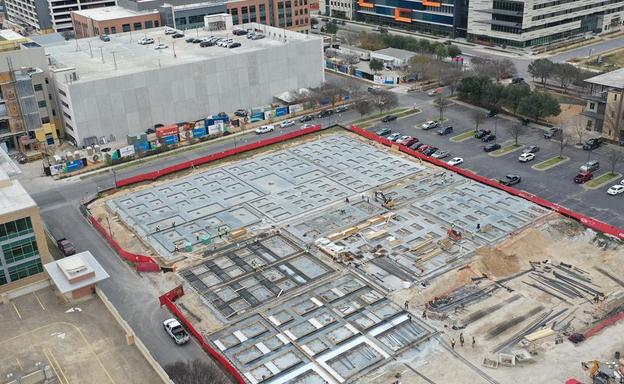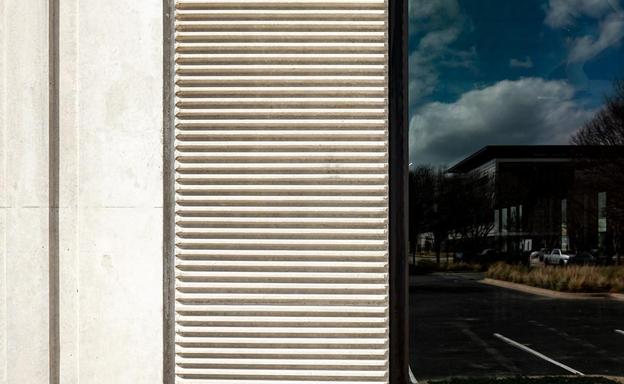1401 Philomena at Mueller
Summarize the project's program, features, and achievements: 1401 Philomena is a new 5-story medical office building located in the thriving Mueller Development in Austin, Texas. The exterior façade showcases an array of concrete patterns that were meticulously poured on the tight project site and lifted into place. Inside, the building features an inviting lobby with unique art, custom millwork, and a generous grand staircase. The medical office building is connected to a standalone 600-car parking garage through an elevated connector bridge, enhancing accessibility and connectivity between the two structures. The 1401 Philomena project sets a benchmark for future developments through its architectural, engineering, and construction excellence. It showcases a harmonious blend of aesthetics, functionality, and the use of tilt-up systems. By achieving LEED Gold certification and incorporating sustainable enhancements, the project demonstrates a commitment to sustainable design practices, promoting environmental consciousness in the built environment. The tilt-up panels in this project are designed to be exposed on the outside and incorporate a variety of patterns and architectural features. These range from ¾" deep vertical and horizontal formliners to areas of heavily textured coating. Each panel had at least three different formliners that added a level of sophistication to the design and complexity to the execution of the construction. The entire team went through numerous mockups, mix designs, and formliner techniques to ensure the concrete looked exactly as desired. A custom mix was developed to achieve a brighter, whiter tint of concrete, which the owner requested. Instead of utilizing the slab on grade for the casting beds, a unique approach of pouring a monolithic casting bed below the slab on grade was utilized to ensure no control joints would be visible on the panels, and the concrete would exhibit a smooth finish. The tilt-up walls extend the entire length of the MOB building, and support a glass crown at level 5, achieving a crisp and modern overall aesthetic. The tight site of the project presented many construction complexities relating to coordination, sequencing, and logistics. The team worked through several iterations of where to place the panels, what type of crane to use, and where to set the crane, to ensure logistic viability. The construction of this project was executed with precision and the contractor developed an extensive quality control process in preparation for lift days. A full QC booklet was created to use in the field to check each panel’s formliners, finishes, joints, and other specific details. Each panel had to go through a full quality control check and receive sign-off from multiple team members before the team moved on to the next panel. Once the details were confirmed, the team executed the pours with accuracy and speed, with an impressive average of 15 minutes per panel to set, level, brace it down, and weld it into place. In its final form, the 1401 Philomena project boasts a blend of unique features and accomplishments and sets a precedent for future tilt-wall construction.
What obstacles were overcome related to the schedule, budget, program, specification, site, etc. on this project? The tight site of the project posed many challenges in terms of construction logistics, sequencing, and coordination that the team had to overcome. The project location is not only surrounded by existing occupied structures but is also tightly tucked away between three narrow streets. During preconstruction, Rogers-O’Brien worked together with the design team to conduct constructability reviews, utilizing our trademarked Collaborative Project Planning (CPPTM) process. First, we had to determine if the panels could physically be poured and lifted into place given the site constraints. The team worked through numerous setting sequences with our steel erector trade partner and developed a 4D sequencing video, along with the bracing configurations. The internal bracing was challenging on this project due to the height of the panels, which required double rows of bracings, and the exposed veneer. All temporary wall bracing was required to be placed inside the building footprint, which meant that the elevated steel and decking construction needed to be carefully coordinated with the removal of braces to maintain stability during the construction process. The tight site also created complexities with crane selection and logistics. We worked with our erector trade partner to identify what capacity crane we would need based on tilt panel weights, where we could set the crane and lift the panels within the narrow surrounding streets, and where the crane would fit between panels as we lifted them in place. RO sequenced out the entire operation beforehand, which was critical to ensuring a successful execution.
Please communicate any engineering complexities or unique features of the panel design for this project. ? The unique 1401 Philomena project design utilized four different form liners and two different textured paints for the 28 tilt-wall panels. We conducted three separate on-site mockups to make sure we got the details right and studied how the panels and form liners came together to ensure a successful execution during the live pours. The RO team also created a QC booklet to use in the field to confirm each specific detail was correct, such as formliner dimensions, chamfered edges, recessed portions, drip edges at panels, joints at and within different formliners, and window openings. Due to the large size of the tilt-wall panels, coupled with the unique architectural features, the structural engineering also presented an array of complexities to the project. The tilt-up panels for this project incorporated many openings of various sizes and support a variety of structural components ranging from floor beams to cantilever exterior canopies to the connector bridge. The presence of large 24’-0”x 12’-6” openings at level 1 and consideration for panel weight drove the panel geometry and resulted in tall narrow legs at the ground level. This condition added complexity to the panel design, and required careful consideration of the impact of lateral loads and heavy gravity loads on the panel legs. This complexity peaks at the panels located at the building entries where a large 22’-0” x 31’-0” openings extend up to level 2 and additionally support the connector bridge where it frames into the panel at level 4.
What is the potential for this project's impact on the community and/or environment? The architectural design of the building adheres to the high standards set by the Mueller development. The project underwent an extensive architectural review process, ensuring seamless integration with the surrounding community fabric and the aesthetic vision of the neighborhood. By meeting these high standards, the project contributes to the overall appeal and character of the community, enhancing the built environment. Moreover, the building's design accommodates a variety of medical office uses, including ambulatory surgery. By providing a state-of-the-art facility for medical professionals, the project directly contributes to the local healthcare infrastructure. In turn, this enables convenient access to quality healthcare services, benefiting community members. And finally, this project demonstrates a dedication to environmentally responsible practices. The LEED Gold-certified project features sustainable design principles, energy-efficient systems, and environmentally friendly materials. The building design incorporates multiple strategies to reduce potable water consumption and utilizes highly efficient HVAC equipment that reduces energy costs by 23%. Moreover, the rebar that was used features 77.8% of recycled content. A central courtyard sprawls beneath the connecting sky bridge of the MOB and covered parking garage which includes a natural grass lawn that reduces the heat island effect and slows stormwater runoff.
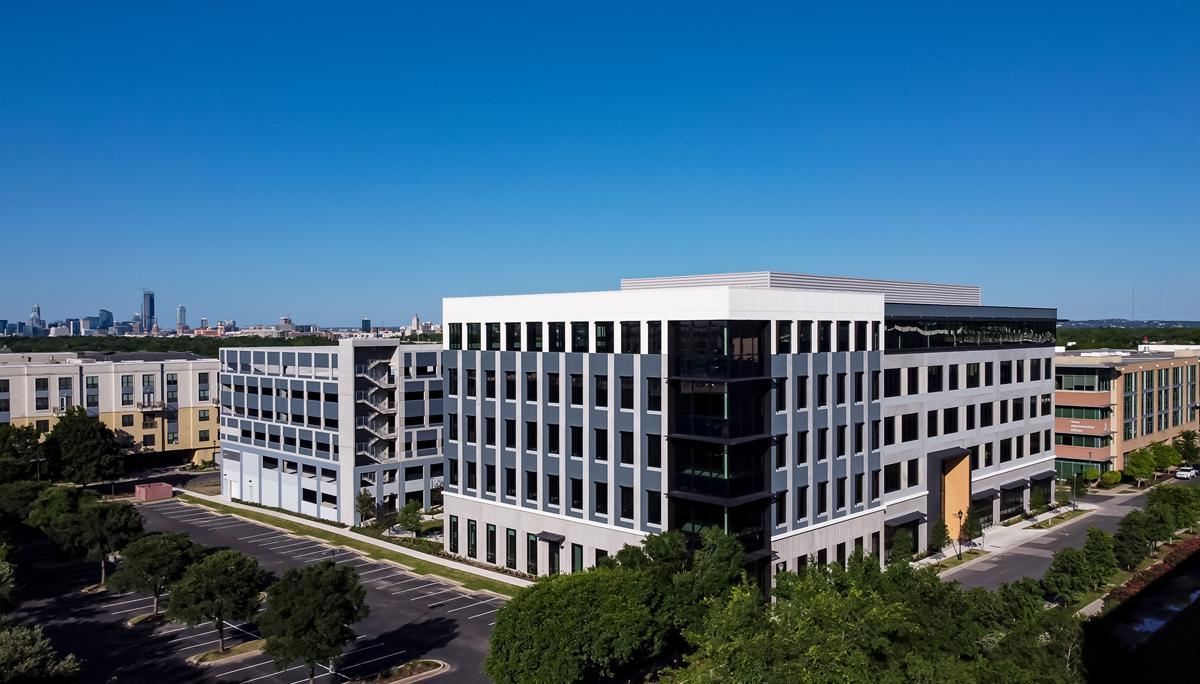
Project Location
Austin, TX 78723
United States
TILT-UP ACHIEVEMENT AWARD
The Tilt-Up Achievement Awards were established to honor projects that use site-cast tilt-up concrete to introduce new building types, advance industry technology and provide unique solutions to building programs. Winning entries illustrate the variety, beauty, and flexibility of tilt-up construction.
EXCELLENCE
2023
The excellence designation is given to the highest scoring projects each year representing the top 10-12 projects. Learn more >
Project Images
Project Team (TCA Members)
- Developer/Owner:
- General Contractor:
- Rogers-OBrien Construction
- Concrete Contractor:
- Rogers-OBrien Construction
- Architect:
- Engineer:
- Datum Engineers Inc
- Suppliers:
- Photographer(s):
- Eric Heimlich
Project Specifics
- Project Category:
- Healthcare
- Building Types:
- Office
- Finishes:
- Concrete (Raw/Sealed)
- Paint (Flat)
- Paint (Textured)
- Features:
- Embedded Items
- Formliner
- Reveals
- Voids
- Insulation:
- Post Applied (Interior)
- Environmental:
- LEED Certified - Gold
- Number of Floors:
- 5
- Tilt-Up Wall Area:
- 30,200 sq ft (2,806 sq m)
- Total Floor Area:
- 130,000 sq ft (12,077 sq m)
- Tallest Panel:
- 67 ft 6 in (20.57 m)
- Widest Panel:
- 30 ft 9 in (9.37 m)
- Largest Panel:
- 1,400 sq ft (130.1 sq m)
- Heaviest Panel:
- 187,000 lbs (84,822 kg)

